Inheritance Cycle – Pack 1 – For the Empire

This week we have the first pack of the new cycle coming out. The cycle marks a shake-up in the status-quo in the story as the consequences of the Emperor’s death unfold. Mechanically, we have the introduction of the Disguised keyword and more cards requiring
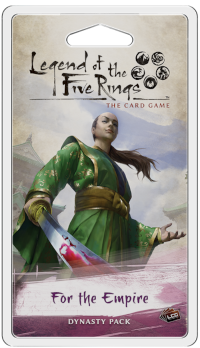
Disguised
This set introduces a new keyword o
You can unveil your disguised character by choosing any non-unique character that matches the restrictions listed on the disguised character. So, in the case of Akodo Zentarō, you could choose any non-unique Bushi that you control. You reduce the cost to play the disguised character from your province or your hand by the printed cost of the chosen character, and when you play the disguised character, you’ll move all attachments and tokens (including fate tokens and status tokens) from the chosen character to the disguised character. Finally, you’ll discard the chosen character from
The big advantage of this is the new character comes into play ready, so the base cost of the original character gets reused. It also means you’ll get to bring any attachments on the original character into another conflict this turn. This provides a 1 turn tempo boost, similar to playing a card that readies your character.
Toshi Ranbo
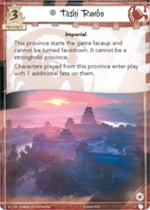
There are lots of drawbacks to this province, as it starts the game revealed it gives your opponent a safe province to attack. This reduces the chance of your opponent hitting one of your more powerful provinces early game. During a conflict, it doesn’t protect itself and only has 3 province strength.
On the other hand, it is active from turn 1. Each time you make a character from it, you get a free fate which can quickly add up over a few turns. Manicured Gardens has always been a popular province, and for that fate, you have to wait for it to be revealed, so Toshi Ranbo has the potential to generate more fate than the most popular fate generating province. Also, it is not an elemental province but instead is a wild card allowing the Scorpion players to drop their worst province and replace it with Toshi Ranbo.
Despite the benefits, the drawback of giving your opponent a ‘free’ attack turn 1 is significant. I have no doubt there is a deck for this province, but I’m not sure we’ve seen it yet.
Scene of the Crime
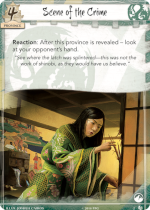
As an earth province Scene of the Crime is competing with Upholding Authority, which is very popular. Upholding will let you look at your opponent’s hand and will also allow you discard all copies of a card they have. Although Scene of the Crime doesn’t have the card discard, it does trigger before you assign defenders rather than requiring the province be destroyed. During that one conflict, Scene of the Crime is going to be a lot better. You can map out the conflict and determine whether you can win the conflict or not. After that conflict, however, Scene of the Crime is essentially blank. As an ‘on reveal’ effect, it’s not going to trigger again (without another card effect). Upholding Authority comes at a significant cost, letting the province break, but does have the potential to change the entire game by removing a key card. Scene of the Crime is information but without impact.
Gateway to Meido
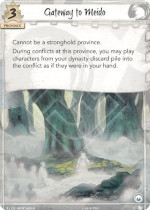
Recursion is one of the pillars of degenerate gameplay, and Gateway to Meido opens up some recursion. As a void province, it has high competition, and this province may actually be a solid inclusion in a few decks. If you have the fate and you have characters in your dynasty discard pile, this lets you make more characters.
Timing is key with this province. Turn 1 this isn’t going to be much help as you’ll have no characters in your discard. Mid game you might be a bit tight on fate. Late game you’re hoping this province is still around and your opponent hits it as Gateway cannot be a stronghold province. That makes this province tricky to effectively use, as such decks with this province may also play Talisman of the Sun to make sure the right province is attacked at the right time.
All that said, if you have enough fate and the right combination of cards you can have some pretty cool combos. The most popular we’ve seen so far is Yasuki Taka, Yasuki Broker, and Vanguard Warrior. Every time the Warrior uses his ability, you get 1 fate from Taka and 1 Fate and a Card from the Broker. That will let you draw your deck and get a big chunk of fate on your characters which you can Jade Tetsubo into your pool. The combo is a bit ridiculous, but even the basic component of being able to pay 2 to reuse the Vanguard Warrior without any of the rest of the combo is pretty great.
Hiruma Signaller

This Hiruma Signaller is very similar to the Vanguard Warrior due to similar stats and a sacrifice ability, in this case, the ability lets you ready and
Fifth Tower Watch
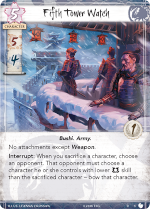
This is the Crab addition in what seems to be a set of army style characters across all the clans. At a chunky 5 cost, the stats are a decent return of 5/4/1 a little less than the clan champions but enough to single-handedly break provinces. The no attachments except Weapon provides some protection against Cloud the Mind, which is the primary way of dealing with problem characters.
The ability is a little tricky to effectively use. After you sacrifice a character due to another effect, you can use this interrupt ability to force your opponent to bow a character of military skill lower than the sacrificed character. So this is never going to take out your opponent’s big military character. If you’re sacrificing a character with lower military skill than any of your opponent’s characters they won’t have to bow anyway. It might result in some weird situations where you end up adding additional military skill to an opponent’s character to force them into bowing another character. Due to the timing, it doesn’t work well with Way of the Crab, as your opponent gets to bow their character first and then sacrifice a character later, so they’ll probably end up bowing the character they want to sacrifice.
The Fifth Tower Watch is an expensive character and can be difficult as it requires another effect to drive the sacrifice and some tricky target selection. It’s not going to be a powerful character, but could make a decent addition to a deck focused on sacrifice effects.
Sententious Poet
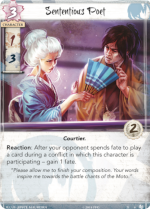
The stats are decent if somewhat uninspiring, but the Courtier trait is always welcome. The 3 cost is the perfect spot to be outside Assassination but still relatively cheap. In an ideal world, the ability would be a 1 fate gain every turn, but that isn’t guaranteed. It might change the opposing player calculations when they play a card, but it is unlikely to stop them playing it.
Esteemed Tea House

Attachment control has been a staple of the environment since pretty much day one. The Esteemed Tea House makes a decent replacement to the Miya Mystic, costing significantly less along with some limitations. You do need to have a participating Courtier, which isn’t a terrible burden for Crane but isn’t always guaranteed. The target needs to be participating, which limits the usefulness against attachments that don’t need to be in the conflict, such as Reprieve and Talisman of the Sun. It is particularly effective against Cloud the Mind as it will prevent your opponent from playing further copies that turn.
Being able to bounce attachments can be offensive as well as defensive. Although you won’t be able to play it until the end of the conflict phase, you will be able to return your own attachments back for play later. That can be a minor thing like bouncing an Ornate Fan back to hand when you know you’ve already won the conflict, or it can be used for other effects like Mark of Shame.
As Crane are already playing Miya Mystic, this will likely go straight into decks as a cheaper replacement. It will leave Crane somewhat vulnerable to attachments outside of the conflict phase (unless they run Let Go), but it will have enough advantages to make it worthwhile.
Magistrate of Reason

As a 4 political Courtier for 4 fate, there is an unreasonable temptation to compare this character with the Crane’s Guest of Honor. The ability certain lends itself in that direction. Where the Guest prevents any events being played, the Magistrate when attacking forces your opponent to pay 1 fate onto a ring to use a character ability. Clearly, the Guest is too good, but it does feel the Magistrate is a little too limited.
First, it only prevents character abilities, the majority of which will already be evident on the table. You already know those options, and your opponent gets to decide whether they should defend with those characters or not knowing they cannot use their abilities. Second, spending fate gives an easy out. Obviously, if the opponent has no fate, they have no options, but once a player sees the Magistrate of Reason on the table, they know they need to retain a little fate. As the ability only works when you’re attacking, your opponent will be able to collect the fate if they declare the next attack.
The Dragon Courtier deck is definitely becoming a real thing, and this character will no doubt play a part in that deck. The ability is situational and may find a place in a fate denial Shiro Kitsuki deck, but for now, I think it misses the mark.
Akodo Zentarō
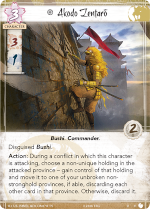
The disguised keyword is new as of this pack and looks like it has a lot of potential. Being able to unbow a character is big, especially in decks like Hisu Mori Toride where you can get additional conflicts, so Zentarō is going to be a popular card. Attacking with one character and overlaying with a disguised character to attack again is excellent! His stats are decent, and the Commander trait is one that should be of interest for the Lion (if not now, in the future).
The ability should be useful as these days every clan has at least one non-unique holding of interest they play. Against Crab decks, in particular, it could be game-changing. Getting Zentarō to turn up in your province row at the right time when your opponent does have the holding is going to be the real trick. Arguably, the stats and ability are enough to make this a playable card even aside from the Disguised keyword, which definitely puts this character in a good position.
Shiba Sophist
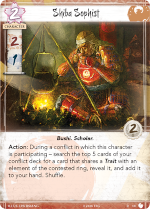
While the Shiba Sophist is very similar to the Agasha Swordsmith, he isn’t quite there. He does need to be in the conflict, and it needs to be a Water conflict. Not terrible limitations, but frustrating enough that you have to work around him. He certainly has potential, a strong element would be the Water ring which would allow access to Against the Waves, Clarity of Purpose, and Supernatural Storm, all of which are potent cards. Assuming a 40 card deck with all 9 cards still in it, roughly 3 out of every 4 times you’ll get a card.
All of these cards are spells, however, and 2 of them specifically require Shugenja. If this were a Shugenja character, its value would be much increased, but Phoenix especially undervalue the Bushi trait. This definitely could see play, card draw is always valued but will struggle to find space in a Shugenja deck and doesn’t have the elemental cards yet for a non-Shugenja deck.
Shameless Gossip

Expect to see this character making its way into Scorpion decks as soon as the pack is opened. Speculation suggests that this is the apology for restricting the Young Rumormonger. The stats of 2/2/1 for 2 are almost exactly what the Scorpion were looking for (maybe 0 glory).
The ability allows the player to move a status token between two characters of the same controller. That means they can move their dishonor tokens onto their Bushi and Shinobi, so the Scorpion Courtiers are ready for Edicts. It helps out Aramoru, making sure he is prepared to use his ability again. It can mess with your opponent’s honor tokens also, keeping their lower glory or bowed character with the honored status. Dishonor decks can offensively use it to move the dishonor status onto a character which is due to leave play soon. The Scorpion will should be very happy.
Shinjo Kyōra
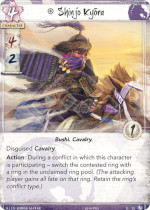
Decent stats, Cavalry, and Disguised are all a great start. The ability can be used one of two ways, if you attack with Kyōra you can use the ability to grab fate from an additional ring, essentially getting a 1 cost discount and denying it to your opponent. Interestingly, it can confound your opponent’s defence, if they’re worried about a ring of air attack and you attack with the ring of fire should they defend? If they do, then you leave it on fire but if they don’t you switch it to air! On the defence, you can use the ability to switch the ring to your opponent’s worst option, negating the advantage they would get from winning and keeping the ring option for your next attack.
The disguised keyword, in particular, is great for Hisu Mori Toride decks where extra conflicts need extra characters. Even when completely bowed out, dropping in this disguised character will open up an extra attack. To do that, you have to have Kyōra in a province, so it is telegraphed to your opponent. Even as the Unicorn deck is getting tighter for options, this is one that should make room.
Hantei Sotorii
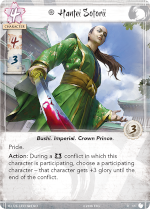
As a 4 cost with 4/3/3 Sotorii is slightly above the curve in stats. The pride keyword fits in nicely with his 3
Give No Ground

Military only, just while you’re defending, and just +2 military for the conflict. Presumably, the benefit here is that the skills cannot be reduced, but those cards aren’t currently a problem. So this seems to be a silver bullet for a problem we don’t have yet.
Moment of Perfect Beauty
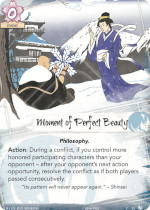
After you play this, your opponent has precisely one action to turn the battle around. On the one hand, this card isn’t going to help you get ahead, it’s almost useless if you’re losing the conflict. You also need to be confident that your opponent doesn’t have that counter-play that will get them ahead. So the card isn’t without flaws.
On the other hand, this is close to peak non-interactive and combined with Voice of Honor it removes almost all of an opponent’s ability to actually play the game. That said, getting the scenario where you have more honored characters and are more than a single action ahead could be tricky. This will be better in a bid 5 meta where each player has a fistful of cards to impact the conflict outcome. It might be a decent 1 slot in Crane as an ender of sorts. Notably, this card has no influence, so it is limited to Crane only.
Greater Understanding
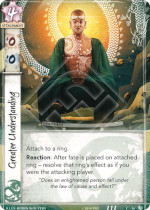
The 4 cost on this card essentially makes it dead on arrival, which is unfortunate, as it looks like it had the potential to be very cool. As the attachment has a reaction rather than a trait, it can only be used once per turn, which limits the effectiveness of the card. This, no doubt, was to avoid scenarios where you could end up triggering the Air Ring multiple times in a single turn honoring out quickly. Unfortunately, this limits the card’s effectiveness.
Togashi Kazue at 3 cost has an ability superior to the Void Ring, but Kazue doesn’t see a lot of play as the environment is heavily anti-attachment. Recent additions to the pool like Hand to Hand and the Esteemed Tea House do focus attachment control on the conflict phase, but the presence of Let Go, Miya Mystic, and Calling in Favors in the Environment still make Greater Understanding a high-risk play. One nice bonus is that unlike characters, rings never leave play. So Greater Understanding will stick around until it is destroyed or the game ends.
All those things aside, once you decide to play the card, you have several options to consider. Obviously, you have each of the rings, all of which are effective in their own way. To get fate onto the ring, you have a range of Dragon characters: Ascetic Visionary, Kitsuki Investigator, Kitsuki Jusai, Togashi Initiate, and Tranquil Philosopher. On the conflict side, you also have Jade Masterpiece. The easiest way, of course, is for the ring to not be claimed during the conflict phase so it will have fate added during the fate phase.
There are a lot of fun options with this card despite the hefty 4 cost. It can be a flexible choosing the ring based on the game state, or it could be the core of a deck where you already know which ring you need it on. As long as it can be so easily destroyed, leaving you out over half a turns worth of fate, it’s too much of a liability.
Blade of 10,000 Battles
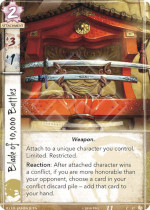
The bonuses are decent for the cost, but it does come with Limited, Restricted, and Unique character only restrictions. Luckily the effect makes up for that. If you’re more honorable, when the attached character wins a conflict, you get to take a card from your conflict discard into your hand. There are a few hoops to jump through, but even recurring just one card a turn is fantastic. Unlike with other forms of recursion, it doesn’t return the card to your deck so you can keep fetching the same card every turn.
For some triggers, you’ll be pulling out the powerful card that helped you win the conflict, maybe a Banzai! You can also grab cards that react to winning the conflict, for example, you can For Greater Glory every turn, fetching it just in time to play it. You can also do this with Fallen in Battle, Spoils of War or Fallen in Battle. Due to the timing, you can Path of Man, then retrieve it, and Path of Man again as the Blade and Path share the same trigger window. This could be an especially attractive splash, Crane, for example, could keep fetching a Voice of Honor or Moment of Perfect Beauty to completely shut down an opponent.
Command Respect

This isn’t Watch Commander, but it is similar. It’s not an attachment that sticks around, but that does make it a bit more of a surprise. It only works when you have fewer cards in your hand, so you need to be at somewhat of a disadvantage for it to work (note – if you’re both equal you cannot play this as the card doesn’t leave your hand until step 6). It only works on events, but it does trade honor rather than just have your opponent lose it, so it opens up the honor victory as well as dishonor.
It does allow the Lion to play a similar game to the Crab where they start bidding low to limit their opponent’s honor and then play Command Respect to force them into trading honor if they want to play their cards. Command Respect is however a once off, one of the big issues with Watch Commander is it there this conflict, and the next, and the next. So it wears you down over multiple conflicts.
Purity of Spirit
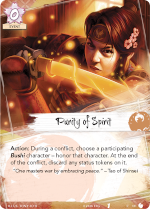
Getting honored up hasn’t always been easy, but it seems things are changing. For 0 fate this is a bargain, but it has to be a Bushi, and it’s only for the duration of the conflict. If you have high glory bushi, then this is a fantastic card. Most clans can pull out a handful of 2 glory bushi, many clan champions are 3 glory champions, while Phoenix have 2 bushi at 4 glory and Isawa Mori Seidō to increase that glory. The Unicorn, in particular, have the battle maidens who are 3 glory bushi making a great case for this. The Crane have several cards that require having more honored characters, so this easy 1 influence option is nice.
The effect is temporary, of course, but hopefully, it is long enough to win the conflict. It can be used to remove an honored status from a character, by playing Purity of Spirit on an already honored character, then they will lose the status at the end. Similarly, if you have a dishonored character, this will return them to normal during the conflict and then at the end of the conflict there is no status token to remove. In some decks, this has the potential to be a +4/+4 for the conflict, it’s a little more realistic to expect a +2/+2 or +3/+3 bonus, which makes it a solid card.
False Loyalties
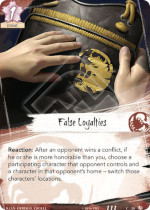
This is a strange one. The best use seems to be to move a small or bowed character out of the conflict just before they would bow and then move in a big character at home to bow them. That is a pretty niche effect that doesn’t often present itself as useful, and to do this, you need to lose a conflict, be less honorable than your opponent, and spend 1 fate! I think this is unlikely to see play.
Adorned Barch

The 2 cost attachments do have their issues, but this is a tremendous
We have started to see a trend with cards like Hand to Hand and Esteemed Tea House of attachment control during conflicts, but the Adorned Barch partially avoids this. You’ll want to keep your character with the Barch out of the conflict until the moment they need to move in, so your bow effect at the very least will remain safe. If your opponent is relying on this kind of card, they will only be able to deal with the Barch after the action has been used. I think we can expect to see this in decks possibly competing with the other clan’s entries in this high power 2 cost attachment theme.
A Perfect Cut
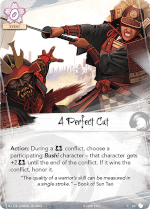
One of the design goals for this cycle is to support Courtiers and Bushi. While Courtiers have had the popular For Shame! the Bushi trait, up until now, didn’t have any cards of the same quality. We’ve already seen the Phoenix card Purity of Spirit in this pack, and now we have a neutral option. This 0 cost event gives + 2 military, which is decent, and if you win the conflict, you become honored! Fine Katana is already one of the most popular cards in the game, and this is a very similar effect to it. If you have a 2 glory Bushi you end up with +2 military for the conflict and then get honored up for another +2/+2 while you retain the honored status. Obviously, this will be better if you have a higher glory character. You do have to win the conflict of course, but that balance is what makes this a particularly fine card.
Summary
This is a really exciting pack, every clan gets at least 1 card of interest, and the neutrals are solid. We get our first disguised cards, and they look great. We also see what we expect to be the start of a series of excellent attachments. Weirdly, we also have 2 surprising duds, the Crab Give no Ground and the Scorpion False Loyalties both just seem bad. Overall, there are enough game changers in this pack that will keep us occupied in the month before the next pack releases.
We also chat about the pack on one of our recent episodes. Note – This episode was recorded based on previews, so where there are differences between the episode and the article, the article is more likely to have the correct wording. Also, we have been known to over-react!
If you have any comments or feedback please post them in the comments section below. Check us out on the Imperial Advisor website, podcast, and YouTube channel for more discussion about the L5R LCG.

6 Replies to “Inheritance Cycle – Pack 1 – For the Empire”
Another thing to note about Purity of Spirit is that it doesn’t dishonour you after the conflict, it discards your status token. So it can be used as a temporary buff for the conflict, as you say, but if your character was dishonoured beforehand the “bonus” stays.
Once this pack gets here I’ll be playing around with IMS again, and Purity, Perfect Cut and Sotorii are all going in.
Good point, I’ll update to make that clear. I think Tsukune is a great example of this, right now she doesn’t see play as she ends up dishonored 90% of the time (among some other reasons). Purity might help her see play.
It’s also good for Aramoro, after you play him with From the Shadows, get him neutral with Purity, use ability, and after conflict he loses dishonor token.
Excellent review with a small correction:
Spies is a max 1 per conflict card, therefore one cannot recurse it and play it with 10k blade.
Good point, I was looking for something in the window too hard I forgot to read the card. I’ll replace it with Fallen in Battle, Spoils of War or The Path of Man.
Damn, spoils and fib are once per conflict too!